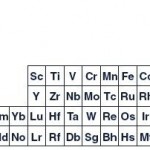 More popular science news with a spectroscopic bent from the desk of David Bradley, this week: Heavy metal and Alzheimer’s – While the protein-like plaques that form in the brains of people with Alzheimer’s disease and in other tissues in a wide range of different disorders are well known, what is less well known is that fairly high concentrations of transition metal elements, including copper, iron, and zinc, are also present. Do these metals have a role to play in plaque formation or are they a side-effect. New research using X-ray and NMR spectroscopy could shed light on the issue and perhaps one day lead to new approaches to therapy based on controlling these metals.
More popular science news with a spectroscopic bent from the desk of David Bradley, this week: Heavy metal and Alzheimer’s – While the protein-like plaques that form in the brains of people with Alzheimer’s disease and in other tissues in a wide range of different disorders are well known, what is less well known is that fairly high concentrations of transition metal elements, including copper, iron, and zinc, are also present. Do these metals have a role to play in plaque formation or are they a side-effect. New research using X-ray and NMR spectroscopy could shed light on the issue and perhaps one day lead to new approaches to therapy based on controlling these metals.
Forgetful quanta – Researchers have, for the first time, monitored oscillations in a vanadium-based molecular magnet. These so-called Rabi oscillations are characteristic of the disturbances that have so far prevented scientists developing a viable quantum bit, or qubit, for use in the next generation of probabilistic computers and encryption devices. According to one independent commentator, the research represents the passing of a milestone on the road to quantum computers. Now that scientists understand the cause of this problem they might be able to address it by swapping atoms with spin for isotopes with zero spin and so cut down on the noise.
More spec news from DB and others on spectroscopynow.com
 My Alchemist column on ChemWeb is live once again: This week’s award is for science that sheds light on a range of physical phenomena including liquid-metal surfaces and condensed matter. The recipient of the award, Oleg Shpyrko of the University of California San Diego, will receive the 2008 Rosalind Franklin Young Investigator Award from Argonne National Laboratory. I asked him what the award means to him:
My Alchemist column on ChemWeb is live once again: This week’s award is for science that sheds light on a range of physical phenomena including liquid-metal surfaces and condensed matter. The recipient of the award, Oleg Shpyrko of the University of California San Diego, will receive the 2008 Rosalind Franklin Young Investigator Award from Argonne National Laboratory. I asked him what the award means to him: I commented on a post on the Bad Language blog, produced by my good friend Matthew Stibbe, earlier this week. He was waxing lyrical about cutting power consumption in his SOHO and mentioned how he prefers to brew tea with freshly drawn water. I pointed out that while this may have benefits it would actually increase his kettle limescale problems through the addition of extra calcium and magnesium ions. The effect will be negligible, but if we are adding up every single kilowatt-second then it could make a difference. Of course, brewing tea is not environment friendly in the first place and we should all really be drinking trapped dew under a hessian bivouac, or somesuch.
I commented on a post on the Bad Language blog, produced by my good friend Matthew Stibbe, earlier this week. He was waxing lyrical about cutting power consumption in his SOHO and mentioned how he prefers to brew tea with freshly drawn water. I pointed out that while this may have benefits it would actually increase his kettle limescale problems through the addition of extra calcium and magnesium ions. The effect will be negligible, but if we are adding up every single kilowatt-second then it could make a difference. Of course, brewing tea is not environment friendly in the first place and we should all really be drinking trapped dew under a hessian bivouac, or somesuch. There have been 32 issues of my science news column on spectroscopynow.com since it was last officially called Spectral Lines, but I thought it was a nice name so occasionally resurrect it here when I highlight the latest research findings I cover on the site. It also gives me an excuse to re-use a logo I did in the early days of the site touting the line “David Bradley On Spec” (geddit?).
There have been 32 issues of my science news column on spectroscopynow.com since it was last officially called Spectral Lines, but I thought it was a nice name so occasionally resurrect it here when I highlight the latest research findings I cover on the site. It also gives me an excuse to re-use a logo I did in the early days of the site touting the line “David Bradley On Spec” (geddit?).
 The
The 
